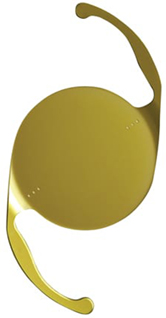Premium Lens Options
ReStor® – Multifocal IOL

The Acrysof® Restor® IOL was one of the very first lifestyle lens implants that achieved a high level of success. The FDA data indicates that 80% of patients were spectacle-free after cataract surgery with this lens implant. Patients often describe that they can see clearly and with more vibrance than ever.
The Acrysof® Restor® IOL is a multifocal lens capable of correcting both myopia, hyperopia and presbyopia. As evidenced by FDA clinical data, this multifocal lens implant can greatly reduce or even eliminate the need for glasses for both distance and reading.
The Acrysof® Restor® IOL is a non-laser lens implant procedure developed specifically for baby boomers or cataract surgery age patients who want spectacle freedom at multiple distances. A lens implant procedure might be a better overall vision correction option for those baby boomers or cataract patients than even LASIK eye surgery.
Explaining Presbyopia and the Aging Eye
When talking about their vision, most people over the age of 45 “focus” on the loss of near vision generally associated with presbyopia or “aging eyes.” What they may not realize is that, in addition to developing cataracts, the inevitable progression of presbyopia weakens the ability of the lens to focus in the field of vision that begins at our fingertips – known as intermediate vision. And, until now, this field of vision, that has become the most important for today’s active Boomers, was severely compromised.
As it turns out, we live most of our “visual lives” in the intermediate range of distance between 26 and 32 inches. In fact, most of our daily lives are lived in the intermediate, also known as “lifestyle vision.” Activities falling within our “lifestyle vision” include:

- Reading facial expressions during a conversation across a table or desk
- Seeing products and prices while walking down the grocery aisles
- Using a computer keyboard and looking up at the monitor
- Reading the speedometer and other dashboard gauges while driving
- Putting a golf ball on the tee
- Baiting a hook for fishing
- Shaving or putting on makeup
- Playing billiards or cards
- Seeing what is on the dinner plate – and the silverware to use to eat it
- Writing a letter or checks to pay bills
- Brushing a child’s hair
- Playing the piano
- Measuring ingredients for cooking and baking
- Ironing clothes
- Dialing a cell phone or using a hand-held computer
- ReStor® is a sophisticated multifocal lens capable of correcting both myopia and presbyopia. It is effective for patients with severe to extreme hyperopia and myopia, which laser vision correction (LASIK, LASEK, and Epi-LASIK) cannot help. This multifocal lens implant can greatly reduce or even eliminate the need for glasses for both distance and reading.
ReStor® is a non-laser procedure developed specifically for baby boomers who want to permanently correct their near vision. This makes it an ideal procedure for people over 55, for whom a permanent correction is often the most important factor in their decision to undergo a vision correction procedure.
Using a multifocal implant, ReStor® can change how the eye focuses light by replacing the aging natural lens in our eye. As we age, the lens inside our eye becomes less flexible and causes our near vision to become blurry. The only way to permanently correct presbyopia is by replacing the aging lens with a sophisticated multifocal implant that has the ability to focus light at both near and far distances.
How ReStor® Works
The Procedure
After the doctor has applied a topical anesthetic (eye drops), an ultrasonic probe is inserted through a very small incision on the side of the cornea (the clear, dome-shaped surface that covers the front of the eye). The tip of the ultrasonic probe vibrates at an extremely high rate of speed and breaks the lens into fine particles which are suctioned out of the eye. Once the lens material is removed, your natural capsule is left behind and the multifocal implant lens is placed inside the capsule. The multifocal lens is implanted in essentially the same capsule previously occupied by the natural lens. You will never feel your implanted lens, and it never has to be handled, adjusted or cleaned. A device called a “speculum” holds your eye open during the procedure.
Once finished, you don’t have to wear a patch and can usually return to normal activities within the next few days. Vision generally begins improving in about a week’s time.
ReStor® can also help patients who have severe to extreme hyperopia or myopia, a condition in which laser vision correction cannot help.
Restor Lens Risks and Complications
ReStor® is associated with a nominal amount of surgery-related complications. Some people who have had ReStor® have experienced side effects that have impaired their vision for a few days after the procedure. Although these risks are relatively rare, they should be taken into consideration by anyone considering the ReStor® procedure. Some side effects include:
- Infection
- Corneal swelling
- Halos
- Over- or under-correction
Toric IOL

Many patients suffer from a common eye condition known as astigmatism. Often astigmatism can lead to blurred or impaired vision if it becomes moderate or severe. The cause of the blurred and impaired vision is the result of the eye’s cornea or lens having an irregular shape. A normal eye’s cornea and lens have a circular shape, whereas an eye with astigmatism has a longer more oval shape.
Eye surgery is not always needed for patients with astigmatism. Most astigmatisms are not severe enough to warrant surgery and can self-correct with contacts or glasses. Only in cases where the astigmatism cannot correct itself and vision becomes too impaired is surgery necessary. Cataract patients who have pre-existing astigmatism can benefit from a surgical procedure that can correct both the cataract and astigmatism. Cataract patients who suffer from astigmatism can request a Toric IOL to correct their vision without the need for contacts or glasses.
Over the past ten years, doctors have looked for ways to help correct astigmatisms in cataract patients. Surgeons have tried to alter the shape of the cornea by making an incision during the cataract surgery. Now, with the creation of the Toric IOLs, vision can be improved or repaired without more surgery. The Toric IOL helps to refocus vision to the eye once the natural lens and the cataract have been removed from the patient. The design of the Toric IOL is also used to correct preexisting astigmatism with the same technology as contact lenses. The Toric IOL has the ability to eliminate dependence on corrective lenses after the patient has had cataract surgery.
The patient’s who have an astigmatic problem and are candidates for cataract surgery can request a Toric IOL to help improve their vision. A Toric IOL can treat both the cataract and astigmatism in one surgical out-patient procedure.
